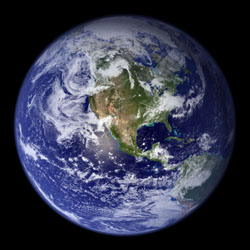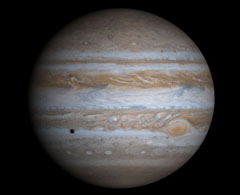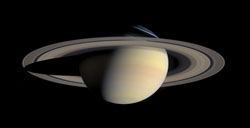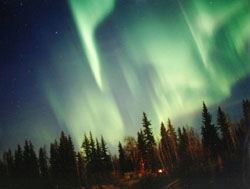Our Eyes See Only a Narrow Range of the Light that Fills the Universe
Our eyes see only a narrow range of the light (called visible) filling the Universe. However instruments allow us to detect light waves that are longer or shorter than our eyes can see. One form of longer-wavelength light is called infrared, which corresponds to heat energy. Even longer are microwave and radio waves. Wavelengths that are shorter than visible light include ultraviolet, X-ray, and gamma ray. The full range of wavelengths is called the electromagnetic spectrum.

An image of Jupiter in visible light (left panel) and infrared light (right panel). Notice that Jupiter’s Great Red Spot is not visible in the Infrared image. The dark spot in the left image is the shadow of Io, Jupiter’s inner most moon. Image Credit: NASA
Secrets of the Bulge
The shape on the outside tells you what’s on the Inside
Every planet is shaped like a ball that is slightly squashed – flat at the top, and bottom, with a bulge around the equator. The amount of this bulge depends on how fast a planet spins and what it is made of.
Which planet bulges the most? (guess by clicking on one of the planets)

Sorry. Earth is made of rock and spins once every 24 hours. While this causes it to bulge a little, it doesn’t bulge nearly as much as the giant planets.

Good guess. Jupiter is made mostly of hydrogen and spins once every 10 hours. Its low density and rapid rotation mike it bulge a lot. But there’s another planet that bulges even more.

Right! Saturn has the lowest density of any planet, and it rotates once every 10 hours and 40 minutes. These factors make it the king of bulge.
Move Over, Everest

Earth also has a bulge around its equator. The bulge is not as prominent as those on the giant planets, since Earth is made mostly out of solid rock. Nonetheless, Earth’s bulge affects what you consider the highest mountain. If your definition is distance above sea level, then the highest mountain is Mount Everest in the Himalayas. If your definition is the greatest distance from foot to summit, then the highest mountain is Mauna Loa on the Big Island of Hawaii. However, if you define it as the greatest distance from the center of Earth, then the record goes to the peak of Chimborazo in the Andes, located right on Earth’s bulge.
Magnetic Attractions
An aurora is evidence of an invisible magnetic field

If you've ever seen the beautiful northern lights on Earth, then you've witnessed visible evidence of an enormous, invisible phenomenon: Earth's magnetic field. Polar lights, or aurora, happen on any planet that has a magnetic field and an atmosphere. The glow is caused when charged particles guided by the magnetic field collide with atoms in the atmosphere and stimulate the emission of light.
All of the giant planets have magnetic fields and aurora, but Jupiter is the champion. Its magnetic field is the largest planetary structure in the Solar System, and it produces more intense radiation than any other Solar System object, apart from the Sun. The rain of Jupiter’s charged particles can “fry” electronics aboard a space probe or kill a human who passes through.

